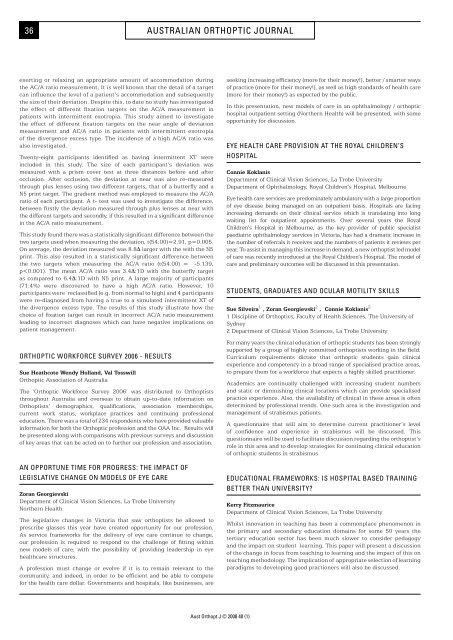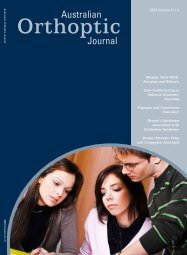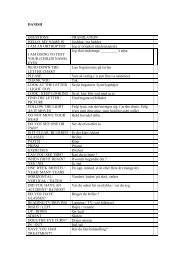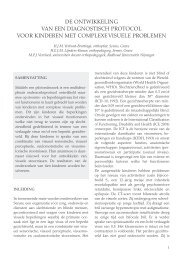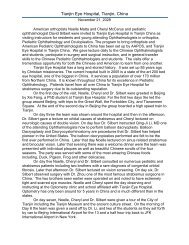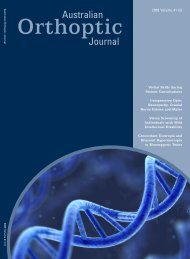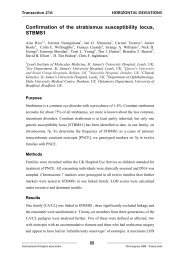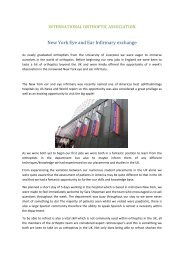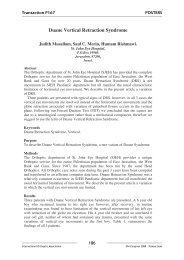Advertising in the Australian Orthoptic Journal - International ...
Advertising in the Australian Orthoptic Journal - International ...
Advertising in the Australian Orthoptic Journal - International ...
Create successful ePaper yourself
Turn your PDF publications into a flip-book with our unique Google optimized e-Paper software.
36<br />
australian orthoptic journal<br />
exert<strong>in</strong>g or relax<strong>in</strong>g an appropriate amount of accommodation dur<strong>in</strong>g<br />
<strong>the</strong> AC/A ratio measurement. It is well known that <strong>the</strong> detail of a target<br />
can <strong>in</strong>fluence <strong>the</strong> level of a patient’s accommodation and subsequently<br />
<strong>the</strong> size of <strong>the</strong>ir deviation. Despite this, to date no study has <strong>in</strong>vestigated<br />
<strong>the</strong> effect of different fixation targets on <strong>the</strong> AC/A measurement <strong>in</strong><br />
patients with <strong>in</strong>termittent exotropia. This study aimed to <strong>in</strong>vestigate<br />
<strong>the</strong> effect of different fixation targets on <strong>the</strong> near angle of deviation<br />
measurement and AC/A ratio <strong>in</strong> patients with <strong>in</strong>termittent exotropia<br />
of <strong>the</strong> divergence excess type. The <strong>in</strong>cidence of a high AC/A ratio was<br />
also <strong>in</strong>vestigated.<br />
Twenty-eight participants identified as hav<strong>in</strong>g <strong>in</strong>termittent XT were<br />
<strong>in</strong>cluded <strong>in</strong> this study. The size of each participant’s deviation was<br />
measured with a prism cover test at three distances before and after<br />
occlusion. After occlusion, <strong>the</strong> deviation at near was also re-measured<br />
through plus lenses us<strong>in</strong>g two different targets, that of a butterfly and a<br />
N5 pr<strong>in</strong>t target. The gradient method was employed to measure <strong>the</strong> AC/A<br />
ratio of each participant. A t- test was used to <strong>in</strong>vestigate <strong>the</strong> difference,<br />
between firstly <strong>the</strong> deviation measured through plus lenses at near with<br />
<strong>the</strong> different targets and secondly, if this resulted <strong>in</strong> a significant difference<br />
<strong>in</strong> <strong>the</strong> AC/A ratio measurement.<br />
This study found <strong>the</strong>re was a statistically significant difference between <strong>the</strong><br />
two targets used when measur<strong>in</strong>g <strong>the</strong> deviation, t(54.00)=2.91, p=0.005.<br />
On average, <strong>the</strong> deviation measured was 8.8∆ larger with <strong>the</strong> with <strong>the</strong> N5<br />
pr<strong>in</strong>t. This also resulted <strong>in</strong> a statistically significant difference between<br />
<strong>the</strong> two targets when measur<strong>in</strong>g <strong>the</strong> AC/A ratio (t(54.00) = -5.139,<br />
p


